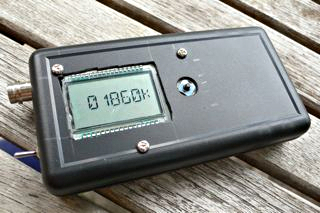 After hearing about them at a NSW Home Brew meeting, I purchased an AD9851 on eBay and have had about a week of frustration trying to program the thing. You need to send them a clocked 40 bit sequence to set the frequency.
After hearing about them at a NSW Home Brew meeting, I purchased an AD9851 on eBay and have had about a week of frustration trying to program the thing. You need to send them a clocked 40 bit sequence to set the frequency.I have been playing with a variety of Atmel AVR processors on various boards and in the end I found some wonderful software for the AVR Butterfly board by Stephen Weber, KD1JV, which has several versions including one for a transceiver and another for a straight VFO. (I'm using the VFO version). Programming was via an AVR ISP MkII rather than the serial protocol, I'm sure either would be fine.
The AVR Butterfly board includes a display and a 4 way rocker switch (plus push) that is used to control the frequency.
 Next steps are to put this in a nice box with more robust buttons, output filtering and amplifier. In summary, this gives the builder a very flexible oscillator for not many dollars. It's certain to become a core part of many future radios coming out of the Marxy lab in the future.
Next steps are to put this in a nice box with more robust buttons, output filtering and amplifier. In summary, this gives the builder a very flexible oscillator for not many dollars. It's certain to become a core part of many future radios coming out of the Marxy lab in the future.So, thanks so much to KD1JV for his excellent software, supplied with source, that has got me started and thanks to members of the NSW Home Brew group including John VK2ASU for his encouragement and offer of a chip in case I'd "smoked" mine.
An AVR Butterfly is about US$20 (a bargain) and I paid AU$50 for the AD9851 plus 30Mhz oscillator and a carrier board, which I consider pretty good all up.
 I've put this prototype in a little box to serve as a portable digital signal generator. Tried to run it off two AA batteries but the voltage was a little low for the 30Mhz oscillator to work reliably. (The AVR Butterfly is perfectly happy at low voltage though).
I've put this prototype in a little box to serve as a portable digital signal generator. Tried to run it off two AA batteries but the voltage was a little low for the 30Mhz oscillator to work reliably. (The AVR Butterfly is perfectly happy at low voltage though).
No comments:
Post a Comment